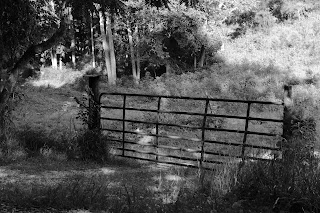There is a large trench that surrounds the village, which was dug out by hand using primitive tools for military defense.The trench is conspicuous against the flat plains that surround it.

Yet, the most conspicuous element in the area are the plateaus that protrude from the plains. This is the namesake of the historic landmark, the Etowah Indian Mounds. The highest mound rises 63 feet from the ground to a flat platform where the chief lived.
The original mounds appeared like primitive pyramids, resembling the much larger pyramids of the Aztecs and Mayans. The chief would speak to the people of the village from a particular corner, which I found would easily carry a man's voice some great distances. I suppose George Whitefield probably could have preached to 30,000 from this platform!
The view from the highest mound, entitled Mound A, is spectacular. One is able to see great distances in the flat lands that surround the mound, which is ideal for defense. In the distance, a series of smokestacks from Georgia Power's Bowen Power Plant.

There is an enduring breadth of wooden stairs that reaches to the top of the Indian mound. The walk is good exercise, and beholding the view from the top is worth the walk. Imagine the chief forgetting something from his home and debating whether to walk up the mound to retrieve it or not!
 There is a spot on the corner of Mound A where the chief would speak to his people. You are able to see one of the lesser mounds from here as well as the large flat land where the village would have been. Some of the lesser mounds have the remains of some nobles, who were buried with elaborate costumes and with earthly treasures for their idea of the after-life. From earliest times, humanity believed we could buy, bribe, or earn our way into heaven. Entrance into heaven is purchased in blood by a perfect Man, who is Christ Jesus, and the payment is not earned or bribed for, but given by grace through faith.
There is a spot on the corner of Mound A where the chief would speak to his people. You are able to see one of the lesser mounds from here as well as the large flat land where the village would have been. Some of the lesser mounds have the remains of some nobles, who were buried with elaborate costumes and with earthly treasures for their idea of the after-life. From earliest times, humanity believed we could buy, bribe, or earn our way into heaven. Entrance into heaven is purchased in blood by a perfect Man, who is Christ Jesus, and the payment is not earned or bribed for, but given by grace through faith.One is able to see the hills that lead to Appalachia from this part of the mound. The stillness and breath-taking view of God's creation calms the soul. The Mississippians believed that these mountains and valleys were formed by an incredibly large vulture that settled here after a long flight, and after flapping its wings the ripples throughout the mountains and valleys developed. Seeing this wonderful view with the knowledge of the truth that God created this marvelous landscape with His word provides a peace these natives did not know.

The Etowah River flows on one side of the village area, which the natives would have been greatly dependent on for fish as well as water for drinking and cleaning.
The view of other mounds from Mound B reveals a lesser mound and an excavated side to Mound A, along with the smokestacks in the distance. The smokestacks adds a bit of human technological advances to a primitive human landscape.



















































 As many of you guys know, I am not a big fan of PhotoShop. However, I had some fun with one of my photographs making it appear old and worn.
As many of you guys know, I am not a big fan of PhotoShop. However, I had some fun with one of my photographs making it appear old and worn.